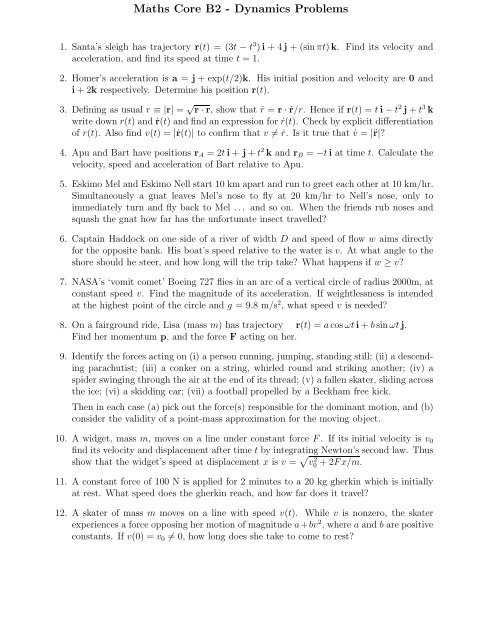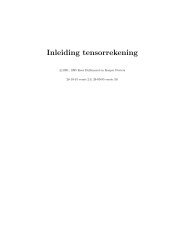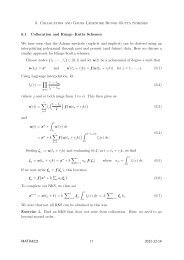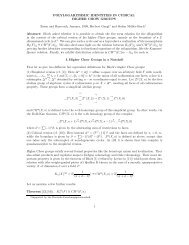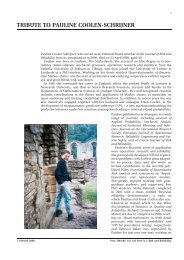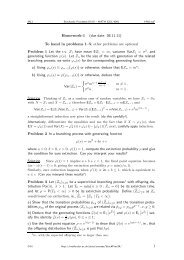Problem Sheet
Problem Sheet
Problem Sheet
You also want an ePaper? Increase the reach of your titles
YUMPU automatically turns print PDFs into web optimized ePapers that Google loves.
Maths Core B2 - Dynamics <strong>Problem</strong>s<br />
1. Santa’s sleigh has trajectory r(t) = (3t − t 3 )i + 4j + (sin πt)k. Find its velocity and<br />
acceleration, and find its speed at time t = 1.<br />
2. Homer’s acceleration is a = j + exp(t/2)k. His initial position and velocity are 0 and<br />
i + 2k respectively. Determine his position r(t).<br />
3. Defining as usual r ≡ |r| = √ r · r, show that ˙r = r · ˙r/r. Hence if r(t) = ti − t 2 j + t 3 k<br />
write down r(t) and ˙r(t) and find an expression for ˙r(t). Check by explicit differentiation<br />
of r(t). Also find v(t) = |˙r(t)| to confirm that v = ˙r. Is it true that ˙v = |¨r|?<br />
4. Apu and Bart have positions rA = 2ti + j + t 2 k and rB = −ti at time t. Calculate the<br />
velocity, speed and acceleration of Bart relative to Apu.<br />
5. Eskimo Mel and Eskimo Nell start 10 km apart and run to greet each other at 10 km/hr.<br />
Simultaneously a gnat leaves Mel’s nose to fly at 20 km/hr to Nell’s nose, only to<br />
immediately turn and fly back to Mel ... and so on. When the friends rub noses and<br />
squash the gnat how far has the unfortunate insect travelled?<br />
6. Captain Haddock on one side of a river of width D and speed of flow w aims directly<br />
for the opposite bank. His boat’s speed relative to the water is v. At what angle to the<br />
shore should he steer, and how long will the trip take? What happens if w ≥ v?<br />
7. NASA’s ‘vomit comet’ Boeing 727 flies in an arc of a vertical circle of radius 2000m, at<br />
constant speed v. Find the magnitude of its acceleration. If weightlessness is intended<br />
at the highest point of the circle and g = 9.8 m/s 2 , what speed v is needed?<br />
8. On a fairground ride, Lisa (mass m) has trajectory r(t) = a cosωti + b sin ωtj.<br />
Find her momentum p, and the force F acting on her.<br />
9. Identify the forces acting on (i) a person running, jumping, standing still; (ii) a descending<br />
parachutist; (iii) a conker on a string, whirled round and striking another; (iv) a<br />
spider swinging through the air at the end of its thread; (v) a fallen skater, sliding across<br />
the ice; (vi) a skidding car; (vii) a football propelled by a Beckham free kick.<br />
Then in each case (a) pick out the force(s) responsible for the dominant motion, and (b)<br />
consider the validity of a point-mass approximation for the moving object.<br />
10. A widget, mass m, moves on a line under constant force F. If its initial velocity is v0<br />
find its velocity and displacement after time t by integrating Newton’s second law. Thus<br />
show that the widget’s speed at displacement x is v = v 2 0 + 2Fx/m.<br />
11. A constant force of 100 N is applied for 2 minutes to a 20 kg gherkin which is initially<br />
at rest. What speed does the gherkin reach, and how far does it travel?<br />
12. A skater of mass m moves on a line with speed v(t). While v is nonzero, the skater<br />
experiences a force opposing her motion of magnitude a+bv 2 , where a and b are positive<br />
constants. If v(0) = v0 = 0, how long does she take to come to rest?
13. As his horse passes the winning-post, a spectator at Ascot (with a cry of ‘Bravo!!’)<br />
throws his top-hat (weight mg) vertically into the air with speed U. When moving at<br />
speed v the topper feels air resistance of magnitude λv 2 . Find an expression for the<br />
maximum altitude it reaches and hence show that its speed V on return is given by<br />
V −2 = U −2 + λ/mg. hint: dv/dt = v dv/dx<br />
14. An object executes simple harmonic motion on the x-axis.<br />
(a) Prove that at the ends of the path the acceleration is maximum and speed is zero,<br />
and that in the middle of the path acceleration is zero and speed is maximum.<br />
(b) If acceleration has magnitude A at distance D from equilibrium, prove that the<br />
period of the motion is T = 2π D/A.<br />
(c) If you had found T = 2πD 2 /A instead, how would you have known at once that<br />
you were wrong?<br />
15. Maggie moves round a circular ride of radius R with constant speed v. Show that her<br />
projection on a diameter executes simple harmonic motion, and find the period.<br />
16. Farmer Palmer, lying stealthily on the (flat) ground, shoots at a trespasser who has<br />
climbed to the top of a tree of height h at distance L away. If the bullet leaves his<br />
gun with speed v then find an equation determining the required angle of projection α.<br />
Show that tanα = v 2 /gL for maximum range, and that then the bullet’s initial velocity<br />
bisects the angle between the vertical and the straight line joining gun and trespasser.<br />
[Ignore air resistance; take g = const.]<br />
17. Show that in standard polar coordinates (x, y) = (r cosθ, r sin θ) the parabolic trajectory<br />
y(x) of simple ballistics derived in the lecture ie.<br />
becomes<br />
y(x) = x tanα −<br />
gx 2<br />
2v 2 cos 2 α<br />
r(θ) = 2v2 sin(α − θ) cosα<br />
g cos2 .<br />
θ<br />
Use this formula to solve the last part of the previous question, ie. to show that in the<br />
Farmer Palmer problem at maximum range the bullet’s initial velocity bisects the angle<br />
between the vertical and the straight line joining gun and trespasser.<br />
18. Tower Bridge slowly opens as James Bond approaches on his motorcycle. Can he jump<br />
the gap? Let d be the span of the bridge, then find an expression for the minimum speed<br />
needed for a given opening angle α. If the span is d = 60m find the minimum speed (in<br />
mph) at angle α = 45 ◦ . (Note that 1m/s ≈ 2.24mph and g ≈ 9.8m/s 2 .) How do your<br />
answers change if Bond’s pillion passenger is fellow-agent Kissy Suzuki?<br />
19. An empty Duff can of constant weight mg feels air resistance equal to −mλ times its<br />
velocity relative to the air. At time t = 0 it is thrown from point r = 0 with velocity v0.<br />
Given a constant wind of velocity V, show that the can’s subsequent position is given<br />
by<br />
<br />
r(t) = v0 − V − g<br />
−λt 1 − e<br />
<br />
+ V +<br />
λ λ<br />
g<br />
<br />
t.<br />
λ<br />
If the wind is horizontal and the can is thrown vertically, show that it returns to its initial<br />
level after time t0 obeying λgt0 = (λv0 + g)(1 − e−λt0 ) where g = |g|, v0 = |v0|.<br />
Hence show that its horizontal displacement is λv0V t0/(λv0 + g) where V = |V|.
20. A quark of mass m, charge q, velocity v in a magnetic field B, experiences force qv ×B.<br />
Take B = Bk (B = const) and let its initial position and velocity have components<br />
(0, 0, 0) and (0, a, c) respectively. Find, and sketch, its trajectory r(t).<br />
21. The ODE ¨r = −ω 2 r describes ‘3-dimensional simple harmonic motion’. Solve it, with<br />
initial conditions r(0) = i, ˙r(0) = pi + q j. What values of constants (p, q) make the<br />
trajectory a circle centred at r = 0?<br />
22. A unit-mass hobbit moves on the half-line x > 0 in a potential V (x) = a log x + b/x 2 ,<br />
where a and b are positive constants. Sketch the graph of V . Is there a stable equilibrium?<br />
If so, find the period of small oscillations about it.<br />
23. A unit-mass wombat moves on the x-axis in a potential V (x) = (x − 1) 2 /(x 2 + 1) 2 .<br />
(a) Find the possible equilibrium points, and sketch V .<br />
(b) Calculate the period of small oscillations about the stable equilibrium.<br />
(c) If the wombat starts from the position of stable equilibrium, how large does its initial<br />
speed have to be so that x(t → ∞) → ∞?<br />
24. A naked man of mass M oscillating vertically at the end of a hanging spring has period<br />
P. What is his period when wearing clothes of mass m?<br />
25. (a) One wheel of a moving car hits a rock. The wheel supports 100 kg of the car’s mass,<br />
and the suspension has spring constant 200 N/m and damping constant 300 kg/s.<br />
The effect of hitting the rock is expressed by the initial conditions z(0) = 0 and<br />
˙z(0) = 1 m/s, where z(t) is the vertical displacement of the car from its normal<br />
height in static equilibrium under gravity. Compute z(t), and sketch its graph.<br />
Find the maximum value of z, ie, the height by which the car bounces.<br />
(b) The car is now moving on a corrugated road surface, modelled by an additional<br />
upward force of magnitude C sin(bvt), where C = 200 N, b = 0.2 m −1 and v is<br />
the car’s constant forward speed. Given v = 10 m/s, and with initial conditions<br />
z(0) = ˙z(0) = 0, find the displacement from static equilibrium z(t).<br />
(c) The same car and the same road — but now the shock absorber has failed, so that<br />
the damping constant is zero. For what value of the car’s speed v (in km/hr) is<br />
there resonance?<br />
26. Two tomatoes moving on a line towards each other with the same speed collide elastically,<br />
and afterwards one is stationary. What is the ratio of their masses?<br />
27. A cyclist of mass m moving with speed v collides with a stationary pedestrian of mass<br />
M, and carries him along on her handlebars. The doubly-loaded bicycle continues with<br />
speed v/3, in the same direction. What is the ratio m/M? What energy is lost or gained<br />
in the encounter, as a fraction of the initial energy?<br />
28. Now Santa’s sleigh (mass m) has trajectory r(t) = ti + t 2 j + t 3 k. Find its angular<br />
momentum L about r = 0 and check explicitly that it is perpendicular to both r and ˙r.<br />
29. The Tooth Fairy’s position as a function of time t is r(t) = ti + t 2 j. Find r(t) ≡ |r(t)|<br />
and hence show that his velocity in polar coordinates is v = {(1+2t 2 ) er+t eθ}/ √ 1 + t 2 .<br />
Find his acceleration also in polar coordinates.
30. The Easter Bunny moves in a plane with constant speed v0 on a spiral curve given by<br />
r(θ) = r0 exp(θ cot α). Show that her velocity is v = v0(cosαer + sin α eθ) and find<br />
her acceleration a in polar coordinates. Show that v · a = 0 and find |a|.<br />
31. Long long ago in a galaxy far far away, a point alien of mass m moved under the influence<br />
of a force of magnitude mc 2 a 4 /r 5 attracting her to a fixed point O at distance r.<br />
She was set in motion at distance r = a from O with speed u. Show that she cannot<br />
reach r = ∞ unless u ≥ c/ √ 2.<br />
32. Find the surface gravitational acceleration of a black hole of radius 10 km, given that<br />
the escape speed is the speed of light equal to 3 × 10 8 m/s.<br />
33. If mass m at distance r from Earth’s centre feels gravitational force F(r) = −GMmer/r 2<br />
then show that its potential energy may be written V (x) ≈ mgx at small altitudes<br />
x above the surface r = R. [nb. gR 2 = GM]<br />
34. Show that the total energy of a spacecraft (mass m) in circular Earth-orbit at altitude h<br />
is E = − 1<br />
2 mgR2 /(R + h) where R is Earth’s radius and g is the usual surface gravitational<br />
acceleration. Hence show that raising a low-Earth-orbit satellite from h1 to h2<br />
needs input of energy E ≈ 1<br />
2 mg(h2 − h1). [nb. gR 2 = GM]<br />
35. The 30 satellites in the US NAVSTAR Global Positioning System occupy nearly circular<br />
orbits and make exactly two complete orbits per day. Given that a geostationary orbit<br />
has altitude 35,600km and the radius of the Earth is 6,400km, use Kepler’s third law to<br />
calculate the altitude of the satellites.<br />
36. The planet Neptune is observed to circle the Sun once every 165 years. What are its<br />
greatest and least distances from Earth? (Earth’s orbit has radius 1.5 × 10 8 km.)<br />
37. A space-probe is in a circular orbit about Mars; find the ratio of its kinetic to its potential<br />
energy. The probe fires its motor very briefly to change its velocity from v to kv with<br />
negligible change in position. (a) Show that it escapes Martian gravity if k > √ 2.<br />
(b) If its orbit’s radius equals Mars’ diameter, find k ∈ (0, 1) for a soft landing<br />
(ie, grazing the surface). [Ignore atmosphere.]<br />
38. An Earth satellite has orbit r = p/(1 + ǫ cosθ). If ˙ θmax/ ˙ θmin = 4, calculate ǫ.<br />
39. A unit-mass pizza experiences a force of magnitude b(r + 1<br />
2 c)/r3 directed towards r = 0.<br />
At time t = 0 it is at r = c with speed b/c perpendicular to r (b, c positive constants).<br />
Use conservation laws to show that its orbit is bounded, and find rmax and rmin.<br />
40. Under the influence of a central force with centre O, a banana moves in a circular orbit<br />
which passes through O. What is the force?<br />
41. Two uniform ideal strings are stretched straight under tensions T and 2T.<br />
If their densities are the same, what is the ratio of wave speeds on them?<br />
What ratio of densities would make the speeds identical?<br />
42. Verify by substitution that each of the following formulas for u (x, t) obeys the onedimensional<br />
wave equation utt = c 2 uxx:<br />
x 2 − 2cxt + c 2 t 2 ; x 2 + 2cxt + c 2 t 2 ; x 2 + c 2 t 2 ; xt.<br />
If u (x, t) = f(x − ct) + g(x + ct), what are the functions f(z) and g(z) in each case?
43. Show that u (x, t) = (A cosαct + B sin αct) sin αx obeys the PDE c 2 uxx = utt for<br />
any values of the constants (A, B, c, α).<br />
Find the values of α such that u (0, t) = u (L, t) = 0 for any fixed L > 0.<br />
Hence write down a series solution to the equation of motion for small transverse vibrations<br />
of an ideal string stretched between two fixed points x = 0 and x = L.<br />
Suppose such a string starts from rest with u (x, 0) = ǫ for x < L/2 and u (x, 0) = 0 for<br />
x > L/2 (ǫ is a small constant). Find the general form of the series solution, and write<br />
out explicitly the first 3 terms.<br />
44. Show that u (x, t) = f(x) cosωt obeys the condition ut (x, 0) = 0.<br />
Suppose that u (x, t) = f(x) cosωt is the small transverse displacement from equilibrium<br />
of an ideal string stretched between fixed points x = 0 and x = L and starting<br />
from rest at time t = 0. By substituting into the 1-dimensional wave equation, find<br />
the function f(x) and the spectrum of allowed angular frequencies ω. Hence give the<br />
relevant general solution to the wave equation as a sum of standing harmonic waves.<br />
45. How does the frequency of the fundamental mode of a vibrating string depend on its<br />
length, its tension, and its mass per unit length? How does doubling the tension affect<br />
its pitch? Doubling its diameter?<br />
46. Small transverse disturbances u (x, t) of a uniform ideal string of length L, fixed at<br />
its ends and stretched straight under constant tension, obey the one-dimensional wave<br />
equation for 0 ≤ x ≤ L with boundary conditions u (0, t) = u (L, t) = 0. If the initial<br />
displacement of the string is u (x, 0) = R(x) and its initial velocity is ut (x, 0) = S(x),<br />
find an expression for u (x, t) in the form of a sum of standing harmonic waves in each<br />
of the cases:<br />
(a) R(x) = sin(2πx/L); S(x) ≡ 0.<br />
(b) R(x) = kx(L − x); S(x) ≡ 0.<br />
(c) R(x) = (sin(πx/L)) 3 ; S(x) ≡ 0.<br />
(d) R(x) ≡ 0; S(x) = v = const.<br />
47. Consider solutions to the one-dimensional wave equation for −∞ < x < ∞ with<br />
u (x, 0) = R(x) and ut (x, 0) = S(x). Use d’Alembert’s formula to find u (x, t) for<br />
t > 0 if R(x) = 1 (|x| < 1), R(x) = 0 (|x| > 1); S(x) ≡ 0.<br />
Support <strong>Problem</strong>s<br />
48. Let a = 3i + 6j + 9k, and b = −2i + 3j + k.<br />
Calculate |a|, |b|, a · b, a × b and the angle between a and b.<br />
49. Let a = −2i + j − 2k, and b = 2i − 2j.<br />
Calculate |a|, |b|, a · b, a × b and the angle between a and b.<br />
50. Let a = i + 2k, b = 2j + 3k, c = i + 3j.<br />
Calculate a · b, a · c, b · c, a × b, (a × b) · c, a × (b × c), (a × b) × c
51. Show that the vectors a = i + 2j + 4k, b = 4i + j + 3k, c = 3i − j − k, are linearly<br />
dependent.<br />
52. Find the solution of the initial value problem<br />
53. Solve the separable equation<br />
54. Solve the separable equation<br />
dy<br />
dt = −e2y , y(1) = 0.<br />
dy<br />
dx = y2 x 3 .<br />
dy x cosx<br />
=<br />
dx yey2 .<br />
55. Find the solution of the initial value problem<br />
dy<br />
dt = 1 − 4y2 , y(0) = 0<br />
and hence determine the value of y(t) as t → ∞.<br />
56. Solve the initial value problem<br />
57. Solve the initial value problem<br />
58. Solve the initial value problem<br />
59. Solve the initial value problem<br />
and hence determine y(π/4).<br />
60. Solve the initial value problem<br />
dy<br />
− 3y = 6, y(0) = −1.<br />
dx<br />
dy<br />
+ y = sin x, y(0) = 1.<br />
dx<br />
dy 2y<br />
+<br />
dx x<br />
= x, y(1) = 0.<br />
d2y = −4y, y(0) = 1,<br />
dt2 4 d2y + 8dy + 13y = 0, y(0) = 0,<br />
dt2 dt<br />
dy<br />
(0) = −2<br />
dt<br />
dy<br />
(0) = 3.<br />
dt
61. Solve the equation<br />
d2y + 2dy + y = 4x.<br />
dx2 dx<br />
62. Use the method of undetermined coefficients to solve the initial value problem<br />
d2y − 4dy + 4y = 25 sinx, y(0) = 6,<br />
dx2 dx<br />
dy<br />
(0) = 0.<br />
dx<br />
63. Use the method of undetermined coefficients to solve the equation<br />
d 2 y<br />
dx 2 − y = ex + sin x.<br />
64. Solve the system<br />
dx dy<br />
= 3x − 4y, = 4x − 7y<br />
dt dt<br />
by first finding a second order equation for y.<br />
65. Solve the initial value problem<br />
dx<br />
dt<br />
= y − 2x,<br />
dy<br />
dt<br />
by first finding a second order equation for x.<br />
66. Prove that<br />
L<br />
2<br />
L 0<br />
= 2y − 5x, x(0) = 1, y(0) = 1<br />
sin( mπx<br />
L<br />
) sin(nπx ) dx = δmn<br />
L<br />
where m and n are positive integers and δmn equals 1 if m = n and 0 otherwise.<br />
Hence show that for a function f(x) defined on x ∈ (0, L) which is written in the form<br />
∞<br />
f(x) = An sin( nπx<br />
L ), then An is given by An = 2<br />
L<br />
f(x) sin(<br />
L<br />
nπx<br />
) dx.<br />
L<br />
n=1<br />
67. Let f(x) = x for x ∈ (0, L). Determine An where f(x) = ∞ write out explicitly the first three non-zero terms of this series.<br />
68. Let<br />
f(x) =<br />
Determine An where f(x) = ∞ three non-zero terms of this series.<br />
69. Let<br />
f(x) =<br />
Determine An where f(x) = ∞ three non-zero terms of this series.<br />
<br />
1 if 0 < x < L<br />
2<br />
0 if L<br />
2<br />
n=1 An sin( nπx<br />
L<br />
< x < L<br />
0<br />
n=1 An sin( nπx<br />
L<br />
) and hence<br />
) and hence write out explicitly the first<br />
<br />
2hx/L if 0 < x < L<br />
2<br />
2h(L − x)/L if L<br />
2<br />
n=1 An sin( nπx<br />
L<br />
< x < L<br />
) and hence write out explicitly the first


